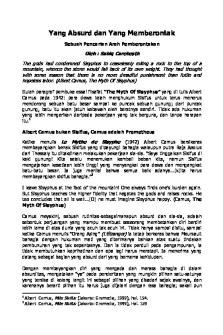Smell - Professor Jian Yang PDF

| Title | Smell - Professor Jian Yang |
|---|---|
| Course | TOPICS-NEUROBIOLOGY & BEHAVIOR |
| Institution | Columbia University in the City of New York |
| Pages | 3 |
| File Size | 120.7 KB |
| File Type | |
| Total Downloads | 26 |
| Total Views | 142 |
Summary
Professor Jian Yang...
Description
olfactory epithelium: lines ~1/2 of interior of nose o axons from olfactory receptor neurons found here project directly to neurons in the olfactory bulb (across gap - cribriform plate) unique among sensory systems bc d/n include a thalamic relay from primary receptors to a cortical region that processes the sensory information o olfactory sensory info is processed in the pyriform cortex why difference between animals and humans in olfactory perception? o increased # of olfactory receptor neurons and odorant receptor proteins in an expanded olfactory epithelium o larger portion of forebrain devoted to olfaction nasal mucosa consists of: o olfactory receptor neurons (ORNs) has single dendritic process that turns into knoblike protrusion from which olfactory cilia extend into a thick layer of mucus direct access to odorant molecules, but also exceptionall exposed to airborne pollutants/harmful substances o bowman's gland - produce mucus that protects exposed receptor neurons/supporting cells of olfactory epithelium o basal cells o supporting cells neural regeneration is a gradual process o most olfactory neurons in rodents are renewed every 6-8 weeks odor transduction o compartmental sensitivity of cilia to odors: odorants evoke a large inward (depolarizing) current when applied to the cilia, but only a small current when applied to the cell body
o
o
odorant receptor gene family olfactory receptor are GPCRs specificity of odorant recognition/signal transduction is the result of this molecular variety of odorant receptor proteins in the nasal epithelium largest known single gene family, representing 3-5% of the genome IN ALL MAMMALS
o
pseudogene - sequence of DNA that cannot be transcribed into a stable mRNA or transcript cannot be translated into a protein o mammalian odorant receptor genes d/n have introns, but invertebrates do mechanism of odor transduction o odorant binds to odor receptor protein -> Golf alpha subunit dissociates -> activates adenyl cyclase III (ACIII) -> increases cAMP -> activates cyclic nucleotide-gated channels (nonselective cation channels - Na+, K+, Ca2+) -> permits entry of Na+ and Ca2+ (mostly Ca2+) -> depolarizes neuron how to turn off response Ther ec ept orpot ent i al i sr educ edi nmagni t udewhenc AMPi sbr ok endownbys pec i fi c o 2+c phos phodi es t er as est or educeI t sc onc ent r at i on.At t hes amet i me,c ompl e x eswi t hc al modul i n a t saffi f o r c AMP . ( ( a1t CAM)andbi ndst ot hec hannel ,r educ i ngi n i t y Fi nal l y ,Cal +I se xt r udedt hr ought he ( a2+f Na+ex c hangepat hway ....
Similar Free PDFs

Smell - Professor Jian Yang
- 3 Pages

MATH10 - Andrew Jian Yu
- 65 Pages

Yang Absurd dan Yang Memberontak
- 7 Pages

Rubah yang Jahil
- 3 Pages

PERNIKAHAN KRISTEN YANG HARMONIS.pdf
- 125 Pages

Analisa Paragraf yang Salah.docx
- 3 Pages

TAI CHI YANG 24
- 3 Pages

Sejarah Dunia yang Disembunyikan
- 633 Pages

Contoh Makalah yang Benar
- 7 Pages

YIN YANG THEORY
- 2 Pages

MENJADI GURU YANG TERAMPIL
- 49 Pages

Classwork 1 - Yaxing Yang
- 1 Pages

Homogenization - Fan Yang
- 1 Pages

Yin Yang Balance
- 26 Pages
Popular Institutions
- Tinajero National High School - Annex
- Politeknik Caltex Riau
- Yokohama City University
- SGT University
- University of Al-Qadisiyah
- Divine Word College of Vigan
- Techniek College Rotterdam
- Universidade de Santiago
- Universiti Teknologi MARA Cawangan Johor Kampus Pasir Gudang
- Poltekkes Kemenkes Yogyakarta
- Baguio City National High School
- Colegio san marcos
- preparatoria uno
- Centro de Bachillerato Tecnológico Industrial y de Servicios No. 107
- Dalian Maritime University
- Quang Trung Secondary School
- Colegio Tecnológico en Informática
- Corporación Regional de Educación Superior
- Grupo CEDVA
- Dar Al Uloom University
- Centro de Estudios Preuniversitarios de la Universidad Nacional de Ingeniería
- 上智大学
- Aakash International School, Nuna Majara
- San Felipe Neri Catholic School
- Kang Chiao International School - New Taipei City
- Misamis Occidental National High School
- Institución Educativa Escuela Normal Juan Ladrilleros
- Kolehiyo ng Pantukan
- Batanes State College
- Instituto Continental
- Sekolah Menengah Kejuruan Kesehatan Kaltara (Tarakan)
- Colegio de La Inmaculada Concepcion - Cebu

